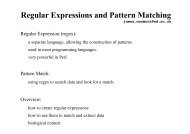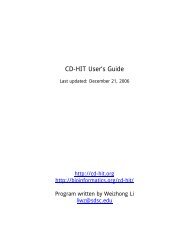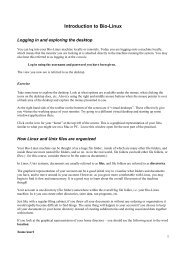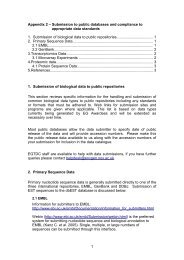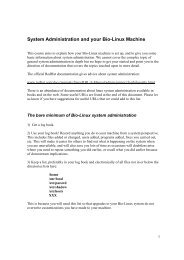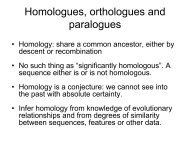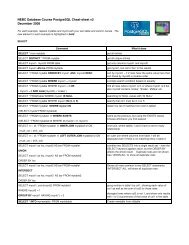Handlebar user guide
Handlebar user guide
Handlebar user guide
You also want an ePaper? Increase the reach of your titles
YUMPU automatically turns print PDFs into web optimized ePapers that Google loves.
Written for <strong>Handlebar</strong> 2.2 - 23/04/10<strong>Handlebar</strong> <strong>user</strong> <strong>guide</strong>Tim Booth, NEBChttp://handlebar.sourceforge.netTable of Contents1 Introduction................................................................................................................22 Getting started with <strong>Handlebar</strong>..................................................................................22.1 Logging in............................................................................................................22.2 Registering a User...............................................................................................32.3 Basic Principles....................................................................................................32.4 The Main “Request” Interface.............................................................................32.5 Sample Labelling.................................................................................................32.6 Quick Query.........................................................................................................43 Detailed Information...................................................................................................43.1 Barcode Lifecycle.................................................................................................43.2 Database Lifecycle...............................................................................................43.3 Security and User Names....................................................................................43.4 Wasting Codes.....................................................................................................53.5 Breaking the Rules and Correcting Mistakes......................................................53.6 Making Collections and Publishing Codes...........................................................54 Data Validation and Quality........................................................................................54.1 Type Descriptions................................................................................................54.2 Data Consistency.................................................................................................64.3 Adding New Type Definitions..............................................................................64.4 Modifying Type Definitions..................................................................................64.5 CSV/Excel Download............................................................................................64.6 Data Upload and Validation.................................................................................64.7 Disposing Codes...................................................................................................75 Other Features of the Web Interface..........................................................................85.1 The Query Interface.............................................................................................85.2 The Printing Interface..........................................................................................86 The Collections System...............................................................................................96.1 The purpose of collections...................................................................................96.2 Making a collection..............................................................................................96.3 Collection names................................................................................................106.4 Editing a collection............................................................................................106.5 Publishing collections........................................................................................106.6 Deleting a collection..........................................................................................117 Setting up and Using the Barcode Hardware...........................................................117.1 Obtaining the hardware for your lab.................................................................117.2 Using the scanner along with the web interface...............................................117.3 Using the scanner within a spreadsheet............................................................117.4 Setting up the printer........................................................................................127.4.1 Windows setup.................................................................................127.4.2 Linux Setup......................................................................................137.4.3 Printing straight from the web interface in Linux...........................13
1 IntroductionThis is the <strong>user</strong> <strong>guide</strong> for <strong>Handlebar</strong>, version 2.0. It is assumed that you havebeen given access to a <strong>Handlebar</strong> database for the purposes of cataloguingyour samples or querying existing sample data. If you do not have access tosuch a database and just want to experiment with the software then a sandboxversion is available via the website at http://handlebar.sf.net. If you arelooking for documentation on setting up or administering your own <strong>Handlebar</strong>database, then please see the deployer's <strong>guide</strong> which is available as aseparate document.2 Getting started with <strong>Handlebar</strong>2.1 Logging inYou will need to know the web address for your database, and to browse tothis address in your web browser. You may be prompted for a <strong>user</strong> name andpassword when you first access the site. If so, you will need to supply theshared <strong>user</strong> name and password used by the whole group, which should havebeen given to you along with the web address. Once you have gained accessto the site you will identify yourself with a personal <strong>user</strong> name before enteringany data.ABCThe 'request' interface presented when you first access <strong>Handlebar</strong>. 1 – Main menuallowing access to other features like reports and printing. 2 – Menu of functionsfound on this form. 3 – Link to create a new <strong>user</strong>.Page 2 of 13
2.2 Registering a UserThis is done via the Register New User link on the main page.2.3 Basic PrinciplesThe fundamental principle of the online database is that all samples are givena unique number, and that information relating to the sample is entered into aspreadsheet against that number. At any time, you can upload the latestversion of the spreadsheet; the database will ingest and store the informationso that it can be seen by all <strong>user</strong>s. It is possible to download the informationfrom the database in spreadsheet form, as inputted, or to perform searching,reporting and exporting operations via the web interface.2.4 The Main “Request and Upload” InterfaceThis contains four main sections:1. Allocate barcodes for use.2. Download data in spreadsheet form.3. Upload a spreadsheet of data.4. Dispose of items in the database.Barcodes are allocated by the system in blocks of up to 1000 (configurable bythe system administrator) and all codes must be allocated before they can beused. The reason for the pre-allocation step is to make sure that all codenumbers are unique. Allocating a block of codes does not mean that you haveto actually use any or all of them. It simply means they are available for use.When you download an empty spreadsheet from the system to enter sampleinformation, it will contain a block's worth of barcodes.The database keeps track of <strong>user</strong>s of the system. Each <strong>user</strong> is identified by ashort <strong>user</strong>name, and each barcode block is owned by one <strong>user</strong>.The database is loaded with templates for various types of things which maybe barcoded. These can be reviewed using the describe type link. The typeassociated with a barcode determines what fields will be available in thespreadsheet when you come to enter data. All barcodes in a block will be ofthe same type.2.5 Sample LabellingThe online database is designed to work with a Zebra barcode printer and PCbasedscanner. However, it is perfectly possible, though tedious, to handwritethe code numbers onto the stored samples. The printing feature on theweb interface supports specific hardware and this is detailed below.Page 3 of 13
2.6 Quick QueryThe “Report and Query” option in the main menu provides a convenient wayto look up a single barcode, as well as access to the report system. For morecomplex query options see “The Reporting Interface” below.3 Detailed Information3.1 Barcode LifecycleThe lifecycle of a barcode in the system is as follows:1. Anything higher than the current highest allocated number is a potentialbarcode, waiting to be claimed by a <strong>user</strong>.2. When a barcode is allocated it becomes associated with a <strong>user</strong> and anitem type as part of an allocation block. At this point no otherinformation is entered, and the barcode may never actually be used. It issimply available for use.3. The system knows the barcode has been used when data about it isuploaded (via a spreadsheet CSV file).4. The barcode information may be updated by editing and re-uploadingthe CSV.5. If the item is destroyed then the barcode can be marked as disposed inthe database. After this it can no longer be updated.It is also possible, though not necessary, to dispose of an allocated but unusedbarcode. This simply tells the database that the code will never be used.Importantly, a code cannot go backwards (eg. once a code is allocated itcannot be de-allocated, once disposed it cannot be reinstated) withoutintervention by the database administrator.3.2 Database LifecycleThe database can also be thought of as having a lifecycle:1. Development phase, where type definitions are being added and tested.This may be done within a test database setup.2. Active phase, where <strong>user</strong>s are storing samples and adding information.3. Archive phase, where the information is archived and no longer updated.A forthcoming release will support the creation and publishing ofbarcode collections for linking into data catalogues etc.3.3 Security and User NamesUsernames are not password protected, as it is assumed that everyone who isgiven access to the system can be trusted. Once you have access to the systemyou can impersonate any other <strong>user</strong>, but obviously you should only do this ifyou are entering data on their behalf. As a safeguard to prevent you fromPage 4 of 13
correct the problem and re-submit the file.Typical problems are:• You have not filled in a compulsory field. If you enter any data against abarcode then you must fill in all the bold fields.• You have put text in a numeric field.• A text entry is too long.• A value in a date column cannot be interpreted. The recommendedformat for dates is, for example, '2005-01-12' for the 12th of January2005. This format will be used by default in the Excel templates. Inparticular, dates in the form '12/01/2005' should be avoided as they areambiguous - many people have their spreadsheets set to the defaultAmerican style mm/dd/yyyy ordering.• There is some extra data in the file which cannot be processed. All cellsbeyond the main table area should be left blank.Some notes on the validation process:• You can re-order the rows and columns in the spreadsheet, if you like,and the database will deal with this.• You do not have to use the whole block at once, nor do you have to useup the codes in order.• You can delete rows you are not using from the spreadsheet, and justupload a subset of the block. The data for these rows will not betouched.• You can manually combine two blocks into one spreadsheet and uploadthe whole lot at once, as long as the owner and types match.• If a row in the spreadsheet contains just a barcode, and the barcode isunused it will be skipped.• But if the row contains just a barcode and there is data for that codealready in the database an error will be triggered.• You can have blank rows in the spreadsheet, but if you put data in anycell outside the barcode data area then this will trigger an error.• Sometimes you may see a validation error which is propogated from theunderlying database. The wording of these can be a little technical, butit is not possible to translate every database error.You can re-request, modify and re-submit the CSV file as often as you like.4.7 Disposing CodesDisposing a code indicates that you have physically destroyed the sample inquestion. Disposing the code lets people know that the sample is no longeravailable and also removes the codes from cluttering up the spreadsheetdownload. The code will no longer show in the tally of codes owned by the<strong>user</strong>. Once a whole block has been disposed the entire block will be hiddenfrom selection lists in the web interface. If a code has been allocated but isnever going to be used you can still dispose of it - this is only really useful ifPage 7 of 13
you want to dispose of an entire block where some codes are unused.You can give a reason for disposal or other comment in the comments box.The date of the disposal will be automatically recorded. The data relating to adisposed code will be preserved and can no longer be changed. You can stillquery on a disposed code via the query interface and there will be a messageindicating that the sample no longer exists, along with the last data logged.Using the barcode scanner, you can place the cursor in the big text box andstart scanning items to build up a list of codes to be disposed. You candispose of whole ranges of codes at once by using colon-separated ranges. Forexample to get rid of codes 20-000120, 20-000121, 20-000122 and 20-000140you could enter into the box:20-000120:20-00012220-000140Please be careful when doing this that you do not dispose of more than youintended!5 Other Features of the Web Interface5.1 The Query InterfaceThe current query interface is a basic lookup form. Enter a barcode (with orwithout the hyphen character) to see a summary of data. The query interfaceis due to be beefed up as follows:1. A reporting interface will allow summaries to be generated with variouspossibly queries.2. A power-query interface will be set up to query across both barcodedatabases. This will only be accessible to certain <strong>user</strong>s like staff at theNERC core facilities.3. There will probably be data export facilities added as required. Theremay be a case for an option where you can download a snapshot of theentire database and query it offline.5.2 The Printing InterfaceIf you want to make labels for your samples the web interface can help you intwo ways:1. By generating an EPL file which you can feed directly to a Zebrabarcode printer.2. By generating a standard e-mail which goes off to whoever has been setup to print your labels.The web interface will validate the codes against the database, and will insistthat codes are allocated to you before you print or request them. The printinginterface is there for convenience only; if you want to make use of thePage 8 of 13
software supplied with the printer to design your own labels then go ahead.Note that the website does not control the printer directly, it just generates asuitable EPL data file for you to print yourself. You will see on-screeninstructions for how to do this.6 The Collections System6.1 The purpose of collections<strong>Handlebar</strong> allocates codes in blocks and uses these for input operations, butfor browsing and publishing the data the original blocks are not necessarilysufficient. For example, you may have results that relate back to 20 originalfield samples. These could be barcoded with codes from two or more blocks,and these blocks may contain other samples that were unused or irrelevant.By making a collection of the codes you can assign an identifier to just therelevant 20 codes. You also have the ability to re-order the codes within thelist.Someone suggested the term “playlist” to describe the role of collections. Justas you might compose a playlist of songs on an mp3 player you can makeplaylists of your barcodes, either for your own use or to share.Collections also provide a mechanism for publishing information from the<strong>Handlebar</strong> database. If the web server has been correctly set up to supportthis feature, you will be able to mark collections as published to be viewablevia a public web site. If you give out your collection identifiers in a paper or ina database (like EnvBase or Array Express) then anyone interested in yourresults will be able to browse and retrieve the sample information from<strong>Handlebar</strong>.6.2 Making a collectionWhile logged into <strong>Handlebar</strong>, in the main interface, select Collections from themenu at the top. You will see a link to “Create an new collection”. This willprompt you for details and a list of codes. If you have a barcode scanner youcan scan the codes directly into the box on the form.It is also possible to make collections from codes you find via the reportmaker. Select the codes you want to collect and click the button labelled“Create collection from selection”.Page 9 of 13
6.3 Collection namesEach collection is given a number. There is also a prefix which is used toidentify the database the collection comes from. For example, in the demodatabase running on the NEBC server all collections have the prefix “coll.00.”and there is a collection called “coll.00.5”. Within the database you can eitheruse the full name or just the number “5” to bring up the collection.You can also give a nickname to a collection if you want. This allows you touse a more memorable name, so for example if this was a collection of soilsamples from Wallingford you could call it “wallingford soil”. There arecertain restrictions on valid nicknames and all nicknames must be uniquewithin the database.6.4 Editing a collectionWhen you bring up a collection in the web interface you will see that thenickname and comments can be edited, and the owner can be changed. Youcan also delete codes or shuffle them up and down using the buttons to theleft of the list. Codes or ranges of codes can be added by listing them in thebox below this. Click 'commit changes' to save the modified collection.The codes in a collection do not need to be of the same type of have the sameowner. You can also put the codes in any order you like. The only limitation isthat a code can only appear once in any given collection. If you try to add thesame code twice the duplicate will be removed. A code my appear in anynumber of collections.6.5 Publishing collectionsThe publication options will only be displayed if this features has been enabledin the configuration.You can opt to publish a collection so that the information you see on thePage 10 of 13
collection screen will be made public. All the data relating to the collectedcodes will also become available.As a convenience, you can also instruct <strong>Handlebar</strong> to release data on relatedcodes. For example, if you publish a collection of DNA extracts derived fromsome soil samples you can check the “All ancestor samples” box and peoplewill then be able to see the information on all the linked soil samplesautomatically. This applies transitively so even if there were intermediatecodes the data will be published all the way back to the original sources.The “All derived samples” box does the same in the other direction. Becareful when using this option as any new codes you link to the publishedcodes will automatically become published. Note that checking either thesecond or third checkbox without the first does not make sense and <strong>Handlebar</strong>will not allow it.As before, click “commit changes” to set the publication status. The messagebelow the three checkboxes describes the current saved setting.You will see a public link listed in the next row of the display. If the collectionis published the link will be clickable. Give this link to anyone who wants toview your sample data.6.6 Deleting a collectionIt is possible to delete a collection entirely. To prevent accidental deletion thebutton on the form is only enabled once the “really” box next to it has beenchecked. The collection will be completely deleted and cannot be undeleted,though the codes themselves are unaffected.7 Setting up and Using the Barcode Hardware7.1 Obtaining the hardware for your labThese instructions relate to the hardware used within the barcoding project atthe NEBC. EPL-capable printers are available from various suppliers, as areuniversal USB barcode scanners.7.2 Using the scanner along with the web interfaceOn either a Linux machine or a Windows PC, the scanner will be recognised asan extra keyboard when it is plugged in. You can therefore use it to readcodes into the web interface (or any other program) as if you were typing onthe keyboard. Pointing a web browser at the query page and then scanning abarcode will immediately bring up the info for that barcode.7.3 Using the scanner within a spreadsheetBecause the scanner acts as a keyboard, codes can simply be scanned toPage 11 of 13
insert the number into a spreadsheet cell.There is also a macro available for OpenOffice.org which allows you to scan acode and immediately jump to the relevant line for that code in thespreadsheet. This is now available for download. Open the file, confirm thatyou are happy to run the macros and follow the instructions. Once the macrois installed it will appear in a Barcode menu or under Tools->Addons as youselect. I have not done much testing on the macro, so let me know if it isproblematic or if you find it useful.You can map the a macro to a function key (I use F4) within OpenOffice.Select Tools->Configure, then click the Keyboard tab. In the Category box(bottom left) select OpenOffice.org BASIC Macros then within that categoryselect barcodemacros and jumptocode. You should see a list of functions nowin the box next door. Select Main from that list. Now in the Shortcut keys boxat the top of the form select F4 (or whatever key you prefer), make sure theCalc option is checked so this shortcut only applies in the spreadsheet, andclick Modify. Select OK to close the form and the new shortcut should now beoperational.7.4 Setting up the printer7.4.1 Windows setupThe printer ships with a driver CD for Windows and some basic label designersoftware. Feel free to experiment with the software and add your experiencesto this WIKI. When trying to use the software on a Windows XP machine atCEH it was found to be quite unstable, but your mileage may vary.To print using the facility on the web interface, you need to persuadeWindows to print raw data files to the printer. This is not as easy as it shouldbe - see this link for a rant on the subject. The steps to follow are these:1. Connect and turn on the printer. You should see a message that newhardware has been found.2. Follow the prompts, inserting the supplied CD when requested.3. Enable sharing of the printer on the network, with the share name"barcoder". This needs to be done regardless of whether you actuallywant to share the unit - see the link above for the reason why.4. Download the zebraprint.bat file and save it somewhere (eg. inc:\windows\system32 if you want to print from the command line).5. Use the web interface to obtain an EPL file and save the file somewhere(eg. on your desktop).6. Open the file. Windows will not recognise the .epl file type so whenprompted choose to select the application maually.○ Give the description "Zebra Raw Barcode Data" in the descriptionbox.○ Browse for the application to use and select the zebraprint.bat filePage 12 of 13
you saved earlier.○ Check the box to "Always use this application"7. When you select OK, your barcodes should begin printing.Once this setup has been done, you should be able to print straight from thebrowser in future, or else simply save the EPL file and double-click it to print.7.4.2 Linux SetupUnder Linux, you need to take the following steps:1. Set up the printer as indicated in the supplied documentation2. Connect the printer to the computer and turn on the printer3. Make sure you have set a root password (see the FAQ entry)4. Click the "Printer Setup" icon on the manager desktop5. Add a new printer, logging in as root when prompted. Please name theprinter "barcoder", as that is the name I am using in my scripts.6. Set the device to "USB Printer #1", assuming you have no other USBprinter connected.7. Choose the make "raw", then "raw queue"8. You can now print EPL files by giving the command:lp -d barcoder file.epl7.4.3 Printing straight from the web interface in LinuxTo set this up, first create a wrapper script to call the kprinter program withthe following two commands./bin/echo -e '#!/bin/sh\nexec kprinter -d barcoder "$@"' | \sudo tee /usr/local/bin/zebraprintsudo chmod a+x /usr/local/bin/zebraprintThis only needs to be done once per machine.Now use your favourite browser to go to the printing interface on the websiteand select "Local Zebra" as the printer. Once you have entered a valid rangefor printing, you will be presented with a link to download an EPL file. Tell thebrowser to open the file with the program /usr/local/bin/zebraprint and aprinting dialog will appear. The browser should remember this as the defaultaction in future.Page 13 of 13




